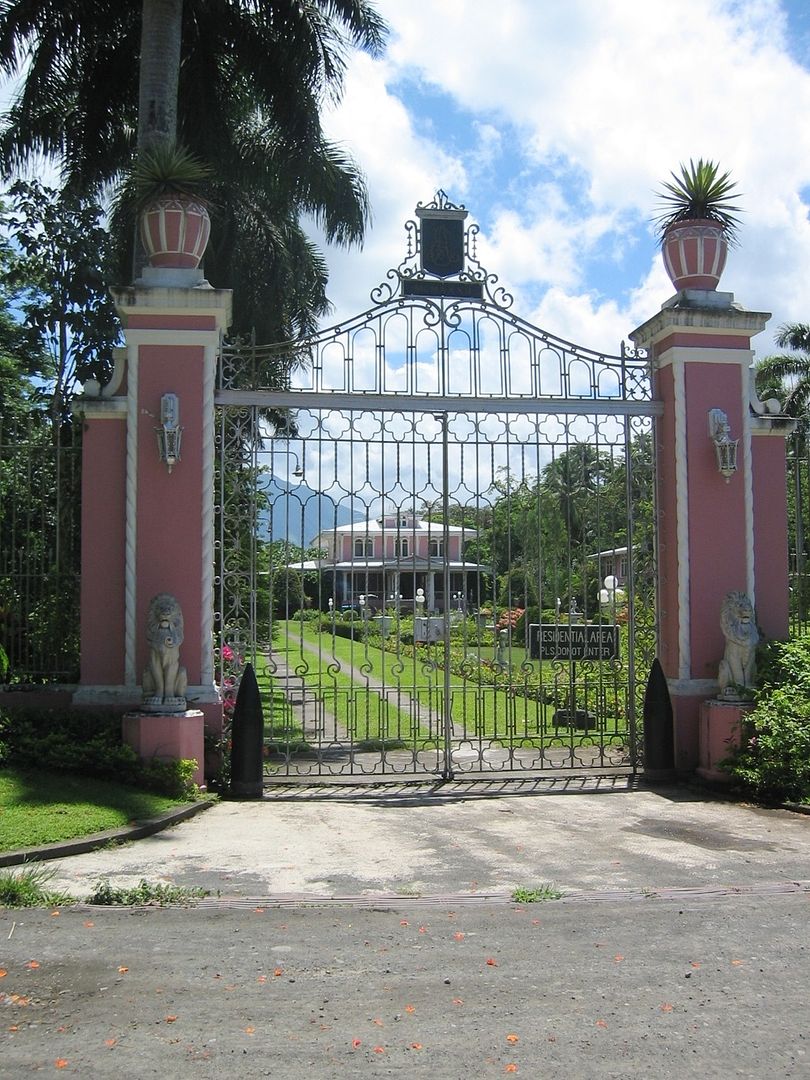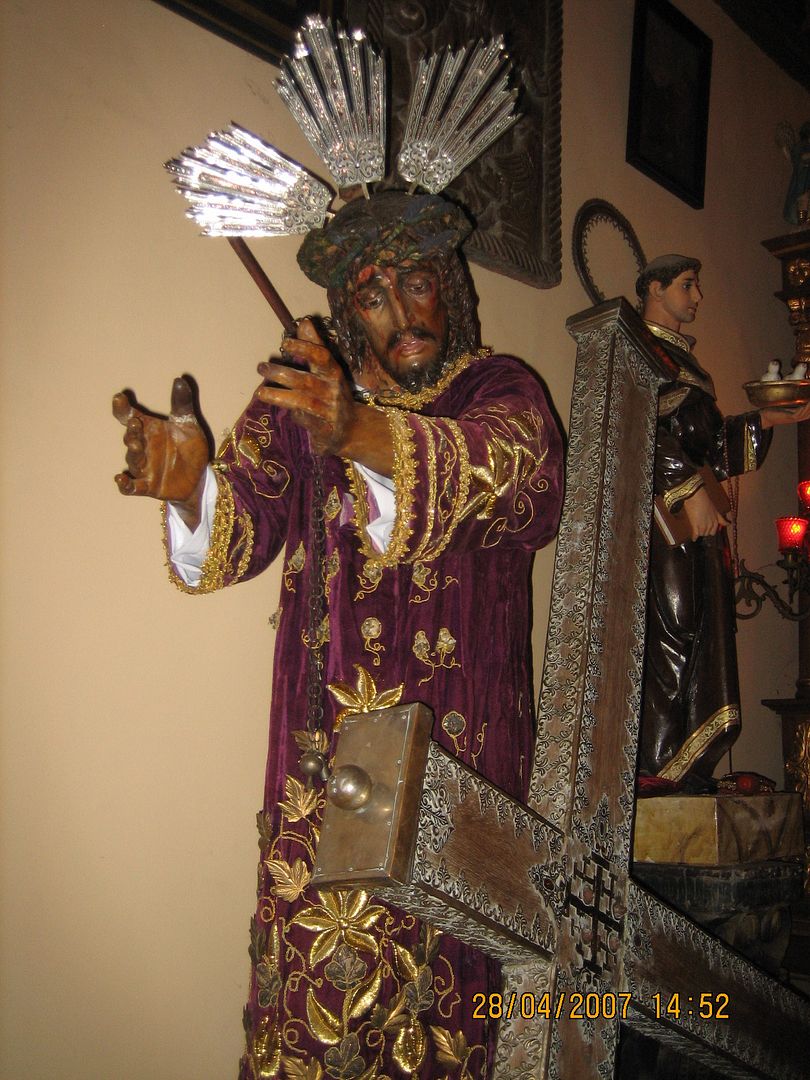When I first visited Villa Escudero in the summer of 2004, I espied an interesting-looking pink-and-white structure in the distance, at the end of a well-manicured lawn and garden path.
There was however a discreet sign in front that said “Residential Area – Please Do Not Enter.” And it didn’t help that it was actually behind a set of ornate and intimidating wrought-iron gates.
So the most that we could do was pose by the fence, with the structure in the far background.
I later learned that that was the actual ancestral house of the Escudero Family. To be precise, it was their vacation house, built in the 1920's as a family get-away from their main house in San Pablo - itself a large mansion that occupied an entire block in the center of town. However, that house was completely destroyed during the Japanese Occupation, so after the War, the family had no choice but to reassemble themselves here in the plantation, and make their vacation house the main family home instead.
The long-hoped-for opportunity to visit it came just this past summer, when Mr. Kiko Vecin, renowned maker of sacred images and other religious art, invited a handful of his younger clients including myself (yes, apparently I still make the “young” cut-off) to visit his lifelong friend and long-running client, Mr. Conrado “Ado” Escudero, the de facto patriarch of the clan today.
The house is definitely American Colonial in style, and is very similar to its contemporaries, those vacation houses in Baguio built by wealthy families from the big city in the decades before World War II.
Flanking this house are smaller and more recent structures built in a vaguely similar style, which have served various functions over the years, including as storage spaces for the family’s extensive collections of religious art and other artefacts.
The front entrance to the house’s main floor is via this wide flight of steps.
However, we’re not to enter just yet, as, after the obligatory visit to the Museum (this time with a running commentary from Kiko), we were treated to a generous buffet luncheon by Ado Escudero, with waiters on call, at a single-storey structure to the left of the main house. Though also similarly-styled to the 1920’s house, this was yet another newer building, especially erected for Mr. Escudero’s parents Arsenio and Rosario in their old age, so that they did not have to negotiate the staircases there. The entire clan would thus take their meals there, and today, even after the passing of the couple, family members and their guests still dine there.
After lunch, Ado leads Kiko and the rest of us back to the main house, accessible from the “lunch house” via these steps, similar to the front entrance, that lead into a side entrance. (Evidently it was really a good idea to have built that new house for the old folks, as passages like this one would be rather difficult to traverse for octogenarians.)
This side entrance is actually quite grand, with a spacious vestibule where stands a period-appropriate hall tree (or what we proles simply refer to as a “hat rack”).
The main living area is accessed from the entrance hall via this doorway.
The living room features, unsurprisingly, wide-plank Philippine hardwood flooring, and choicest antique furniture and artworks.
There are two more “mariposa” (butterfly-backed) settees in residence.
And more than one of these Spanish Colonial console tables.
If one doesn’t like mariposa settees, here’s a more formal and four-square affair.
But the real star of this space was a large (quite an understatement) marble-topped table, supported by six sphinx figures.
It is attributed to the late 19th century master sculptor Isabelo Tampingco, and the one-piece marble slab is believed to have come all the way from Italy via the Suez Canal.
For fans of marble slabs, the dining room features yet another marble-topped dining table.
I’m however a bigger fan of antique chairs, so I shot these photos for my picture collection.
Another room on the ground floor contains a library-study, with tasteful if somewhat more modern-looking built-in bookcases.
It wouldn't be an Escudero Home without an impressive family altar, and indeed, the one on the ground floor features a mind-boggling Niño Dormido.
The Escudero Ancestral House does not just feature the best examples of antique Filipino furniture; it is also a showcase for increasingly rare antique Filipino colonial lighting fixtures, such as these.
The front veranda (open porch), now enclosed and glazed, is lined with original machuca (painted cement) tiles. That’s famed religious-image-garments-maker Ramon Gutierrez, also part of the Kiko Vecin gang, seen chatting with Ado Escudero.
This veranda has even more of those antique hanging lamps around it, in every imaginable shape, color, style, and size.
And we may look out from here towards the main gate, to appreciate the formally-laid out gardens.
One final shot on the front steps with Ado and his guests (this photographer not included).
- - - - -
Our second Akyat-Bahay session for the day involved Ado Escudero’s own house itself, some distance away from the main house. To get there, we had to take our vehicles and drive a few hundred meters behind the ancestral house.
This recently-built structure was totally different in conception, being essentially "Balinese" in style - single-storey, squarish, high-ceilinged, and wide and spacious. These characteristics actually make it a perfect repository for the extensive holdings of the prolific collector-in-residence. As usual, Ado and Kiko lead the way in.
The contents of this house are too numerous and abundant to feature in just one article, and also in deference to the owner’s privacy, I prefer not to do so in my usual detail. Let me instead just point out a few of my favourites, beginning with this standing Nazareno from the 1970’s (cross not properly positioned).
There is also a Cristo Desmayado.
And a large crucifix, used to head up the Holy Week processions in San Pablo.
The large dining room
features an interesting, non-clicheish, Last Supper on the wall
and generous-sized plateras (flatware and glassware cabinets) at both ends.
But for me, the real treasures in Ado's Balinese house were to be found in the kitchen, of all places. No, not food (for we were anyway well-fed throughout the day), but antique botica cabinets.
These were actual cabinets from 19th- and early 20th-century pharmacies in the Philippines, used to store potions, powders, oils, and whatever else they used to dispense to sick people and hypochondriacs like me in those days.
Today, they find a variety of excellent 21st-century reapplications – as library bookcases, for example (my family and I have several of them in this particular service). Ado Escudero has ingeniously used them to hold his extensive collection of flatware, cutlery, and other kitchen utensils.
My bias for unusual antique Filipino furniture, in seeming preference to antique religious images, is thus betrayed. The extensive private collection of santos in this house will therefore have to be appreciated in person by the few who manage to wangle an invite to visit.
Consider yourself lucky, even blessed, should you be one of them. I certainly did and do.
friendsofsanroque wrote on Aug 28, '07
iam dying to have that marble table as well as the sto. nino dormido =)
|
persognare wrote on Apr 27, '08
linking this up to my villa escudero post... i hope i can go inside the mansions, too! :)
|





















































No comments:
Post a Comment